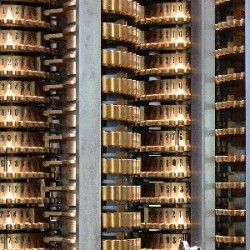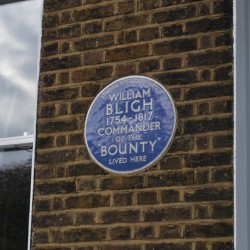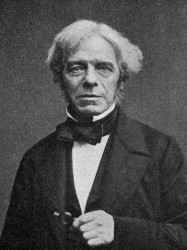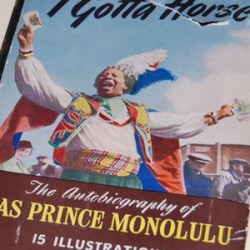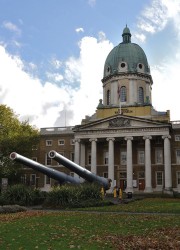In 2017, an exceptionally rare Roman sarcophagus was discovered at Harper Road. It has since been excavated, removed from its ancient grave site and taken to the Museum of London, where its contents will soon be carefully exhumed.
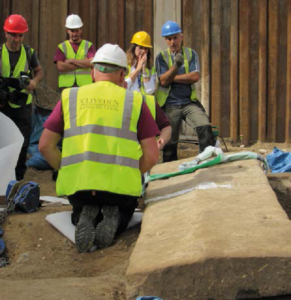
This is not the first Roman burial to be found here. In 1979, the skeleton of ‘Harper Road Woman‘ was discovered, along with Roman grave goods including a flagon, mirror and necklace. But this latest discovery includes a sarcophagus (which translates as “death eater” in ancient Greek); a form of stone coffin rarely found in London. It adds weight to the idea that Southwark was much more important to the Romans than previously thought.
The wealth of Roman material found in London excavations can sometimes obscure the significance of evidence from the original settlers, whose goods and homes did not survive so well. It’s now understood that pre-Roman Britain had more sophisticated settlements, roadways and trading relationships than was often assumed and this may include the northern part of Southwark.
The Romans first attempted an invasion of Britain under Julius Caesar, but it wasn’t until 43 AD, under Emperor Claudius, that they successfully conquered the Britons and established themselves here permanently.
Despite failing to secure a foothold, Caesar’s forces had managed to scope out a great deal of territory and get a feel for the native populations. So, by the time of Claudius’ invasion, the south of Britain was already well known to the Romans and trading relationships with the local tribes were already established. Nonetheless, the period between landing and establishing a major garrison city, known as Londinium, roughly seven years later, proved to be a serious challenge for the invaders.
At that time, the Thames was wide and marshy and full of inlets and islands. The section of the river around modern Southwark was shallower than most and had already been earmarked for a proper crossing by Caesar’s expedition.
Around 43 AD, in order to service this crossing, Claudius’s forces set up major camps on the south as well as the north side of the Thames. The Southwark camp grew and eventually included a major port; garrisons; entertainments; workshops; warehouses; wealthy homes; burial sites and places of worship.
The Roman roads converged at Elephant and Castle
The Romans’ main roads from the south coast to Londinium converged at what is now (roughly speaking) Elephant and Castle, making the area between the Elephant and the river an important meeting place for all kinds of travellers (just as it is today). And, of course, people needed something to do while they waited to cross the river to the city and it wasn’t long before the area became less of a troop camp and more of a vibrant small town. As a consequence, northern Southwark emerged as Londinium’s first major suburb.
While it was the upper end of present day Borough High Street that became the major focus of activity, the roads reaching to the south were dotted with small settlements, burial grounds and memorials. Recent research has revealed that this area was primarily used for Roman rituals.
The area that incorporates present day Lant Street, Trinity Street, Dickens Square and Harper Road, is now known to form the site of a complex ritual landscape. It contains various religious and funerary monuments and a vast, dispersed Roman cemetery that incorporates a range of burial practices, often with exotic grave goods sourced from across the Roman Empire.
For example, the grave of a 4th century 14 year old girl was discovered in Lant Street. It represents one of the richest interments from the Southwark cemetery and is without parallel in Britain. Her chalk-burial contained a bone inlay box and an ivory clasp knife decorated with a leopard design, as well as glassware.
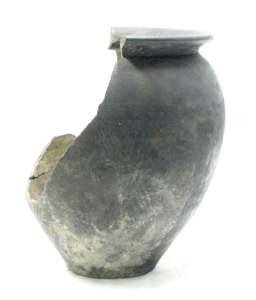
Our Roman forebears brought all their ‘cultural baggage’ with them and left us clues about their attitudes to death, burial and spirituality. It’s evident that Roman London was a multi-cultural city, with a population drawn from across the empire adding to the mix of different religious practices and beliefs. But the local Britons and their Roman occupiers also mixed; through trading, marriage and other relationships. Their beliefs and practices often blended together too, including their ways of burying and remembering the dead.
Britons usually buried people in a crouching, upright position in graves. The Romans brought their own practices (such as cremation and burial of the ashes in urns) but in the 2nd century the idea of burying the whole body intact, in lead-lined stone coffins, emerged. The discovery of the Harper Road sarcophagus promises to reveal even more about this practice as well as the local funerary landscape and the Romano-Britons’ approach to death.
Unfortunately, the excavation also revealed that a large robber trench had been dug around the coffin. The lid had been moved, suggesting that it had been discovered and robbed at some point in the past. Archaeologists believe it’s possible that only the precious items were removed, and that the artefacts considered less valuable by the robbers – such as the body itself – still remain in situ.
Only two similar sarcophagi have been discovered in their original place of burial in London in recent years (both on the other side of the river) so this represents an exceptional find for London and especially for Southwark. If the skeleton survives, it will make an incredible contribution to our knowledge of Roman London and our borough’s part in its history.



